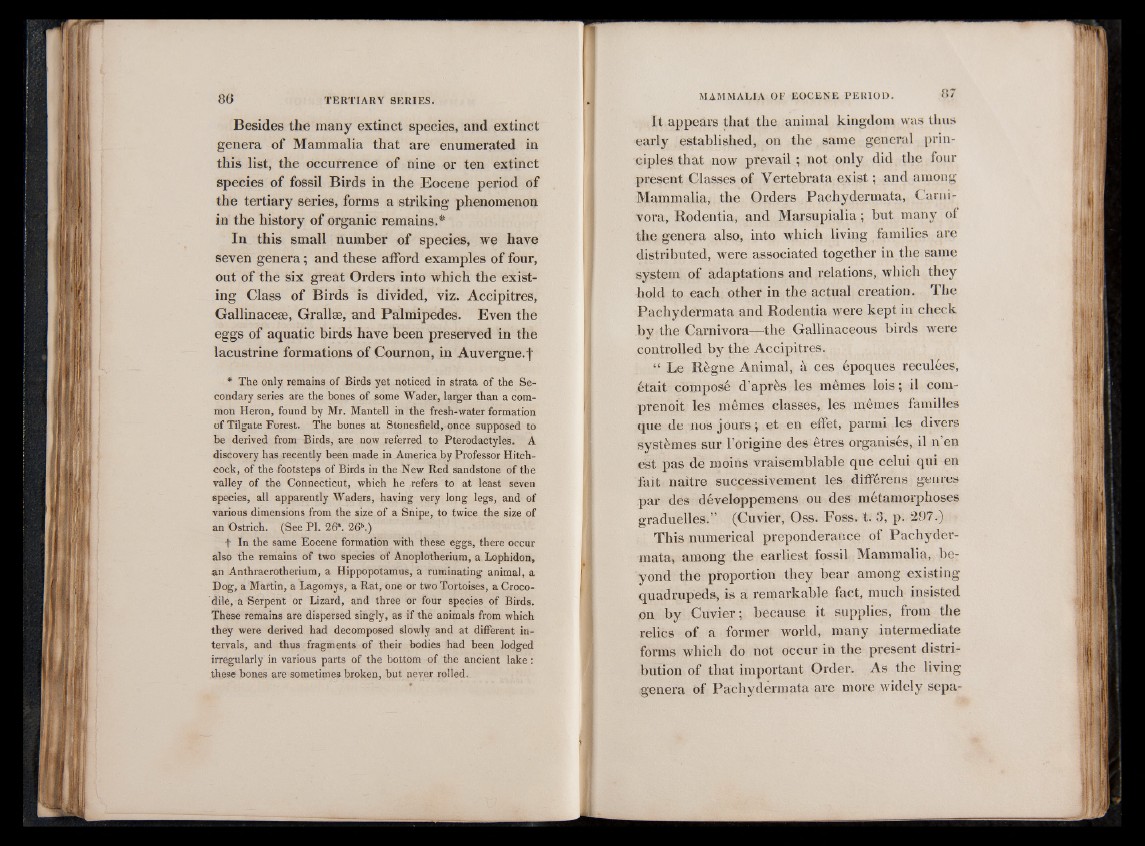
Besides the many extinct species, and extinct
genera of Mammalia that are enumerated in
this list, the occurrence of nine or ten extinct
species of fossil Birds in the Eocene period of
the tertiary series, forms a striking phenomenon
in the history of organic remains.*
In this small number of species, we have
seven genera; and these afford examples of four,
out of the six great Orders into which the existing
Class of Birds is divided, viz. Accipitres,
Gallinacese, Grallae, and Palmipedes. Even the
eggs of aquatic birds have been preserved in the
lacustrine formations of Cournon, in Auvergne.']'
* The only remains of Birds yet noticed in strata of the Secondary
series are the bones of some Wader, larger than a common
Heron, found by Mr. Mantell in the fresh-water formation
of Tilgate Forest. The bones at Stonesfield, once supposed to
be derived from Birds, are now referred to Pterodactyles. A
discovery has recently been made in America by Professor Hitchcock,
of the footsteps of Birds in the New Red sandstone of the
valley of the Connecticut, which he refers to at least seven
species, all apparently Waders, having very long legs, and of
various dimensions from the size of a Snipe, to twice the size of
an Ostrich. (See PI. 2 6 \ 26b.)
f In the same Eocene formation with these eggs, there occur
also the remains of two species of Anoplotherium, a Lophidon,
an Anthracrotherium, a Hippopotamus, a ruminating animal, a
Dog, a Martin, a Lagomys, a Rat, one or two Tortoises, a Crocodile,
a Serpent or Lizard, and three or four species of Birds.
These remains are dispersed singly, as if the animals from which
they were derived had decomposed slowly and at different intervals,
and thus fragments of their bodies had been lodged
irregularly in various parts of the bottom of the ancient lake:
these bones are sometimes broken, but never rolled.
It appears that the animal kingdom was thus
early established, on the same general principles
that now prevail ; not only did the four
present Classes of Vertebra ta exist ; and among
Mammalia, the Orders Pachydermata, Carnivora,
Rodentia, and Marsupialia ; but many of
the genera also, into which living families are
distributed, were associated together in the same
system of adaptations and relations, which they
hold to each other in the actual creation. The
Pachydermata and Rodentia were kept in check
by the Carnivora—the Gallinaceous birds were
controlled by the Accipitres.
“ Le Règne Animal, à ces époques reculées,
était composé d’après les mêmes lois ; il conv
prenoït les mêmes classes, les mêmes familles
que de nos jours ; et en effet, parmi les divers
systèmes sur l ’origine des êtres organisés, il n’en
est pas de moins vraisemblable que celui qui en
fait naître successivement les différens genres
par des développemens ou des métamorphoses
graduelles.” (Cuvier, Oss. Foss. t. 3, p. 297.)
This numerical preponderance of Pachydermata,
among the earliest fossil Mammalia, beyond
the proportion they bear among existing
quadrupeds, is a remarkable fact, much insisted
on by Cuvier ; because it supplies, from the
relics of a former world, many intermediate
forms which do not occur in the present distribution
of that important Order. As the living
genera of Pachydermata are more widely sepa